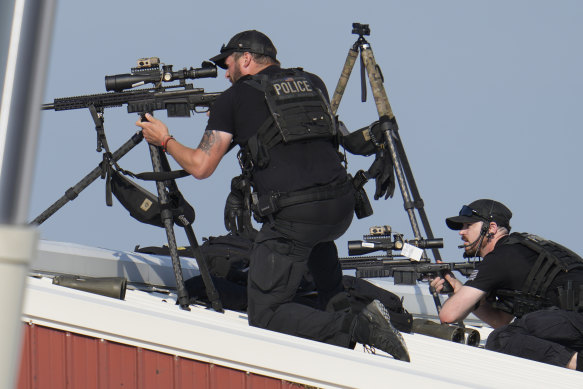
Rowe said the review found flaws in both the advance planning ahead of Trump’s visit and its implementation. The security breaches were due, in part, to “complacency” by some agents, and the employees involved “will be held accountable,” Rowe said. He repeatedly declined to elaborate on what specific discipline they could face. Rowe also declined to say how many agents could face discipline, but said he had not asked anyone to retire.
The review is separate from a probe looking into a second possible assassination attempt against Trump last weekend. A Secret Service agent saw an armed man on the perimeter of the Trump International Golf Club in West Palm Beach, while Trump was golfing, and the agent fired shots. No one was injured and the suspect was later arrested. Rowe and Trump have praised the agents for their planning and security during that incident.

Police snipers after shots were fired while Republican presidential candidate Donald Trump was speaking.Credit: AP
Rowe described the results on Sunday as a success, saying that the agent who spotted the armed man “identified a threat … and he made swift decisions and took a swift action to be able to mitigate that.”
Trump is getting the highest level of Secret Service protection, similar to President Joe Biden, and receiving “more robust” security than other former presidents since leaving office, Rowe said.
“While July 13 is a failure, we’re not proud of it, but we certainly have been rising to this moment,” he said. Agents “are working tirelessly to make sure that the people we protect are safe.”
Rowe has said the July 13 security breach was not a result of a lack of resources, but a failure to anticipate a possible threat.
Loading
“We’re in the risk-mitigation business,” Rowe said. “We are not in the risk elimination business. And so we have to be able to have the personnel, the assets, and be able to spread those out for an indefinite period of time in the event that another situation … requires us to do so.”
He said the Secret Service began making changes soon after the July 13 breach, including expanding security for Trump and others under the agency’s protection. More than 40 officials, families and foreign dignitaries have protective details.
The report about July 13 comes as the Secret Service and its overseeing agency, the Department of Homeland Security, are negotiating with Congress to dramatically increase the agency’s budget to expand the number of agents and investigators, to upgrade equipment such as armored limousines, and to create more realistic training studios at the agency’s dated training center in Maryland.
Officials have declined to provide details about how much they want the $3 billion a year, 7,000-plus employee agency to expand, but DHS Secretary Alejandro Mayorkas said in an interview this week that the agency is seeking a “significant” budget increase.
Rowe also said he is actively involved in negotiations with Congress in hopes of increasing the agency’s budget, staffing and technology. He said he will hire more than 400 special agents over the next year and that applications “are at an all-time high.”
“We are not capitalizing on a crisis. We are showing the math,” he said of his efforts to secure more funding. “I am hopeful and I am certainly engaged in these discussions and I feel like in the end that we will get there, because we have no other choice.”
Multiple additional investigations are ongoing into the shooting, including by the FBI, Congress and the DHS inspector general, the agency’s independent watchdog.
President Joe Biden also ordered a 45-day independent review of the Secret Service’s preparation and handling of the rally and its overall policies and procedures. The review’s results are expected in early October, DHS has said.
Most of the summary focuses on lapses in the Secret Service’s advance team and its coordination with state and local law enforcement before the attack.
Secret Service agents and state and local law enforcement used different radio frequencies and gathered in separate facilities, hindering them from urgently sharing information electronically or in person. The Secret Service had its own security room, while Butler County Emergency Services had a separate command post.
As a result, when local authorities were searching for Crooks in the crowd, some did not know that the Secret Service was not directly hearing their radio transmissions, the report said.
“If this information was passed over Secret Service radio frequencies it would have allowed [Trump’s] protective detail to determine whether to move their protectee while the search for the suspicious suspect was in progress.”
Instead, this vital warning was transmitted in “staggered or fragmented fashion” via mobile phones.
Secret Service agents and a local tactical team operating on the second floor of the American Glass Research building, where Crooks climbed on top of the roof, did not plan beforehand to cover the building, even though it had a clear line of sight of the podium where Trump spoke that day.
Internal investigators found the local snipers would have positioned themselves on top of that roof had they been asked.
Trump’s protective detail had a counter drone system for the visit to Butler but they experienced technical difficulties and did not use it.
“It is possible that if this element of the advance had functioned properly, the shooter may have been detected as he flew his drone near the Butler Farm Show venue earlier in the day,” the report said.









 Add Category
Add Category